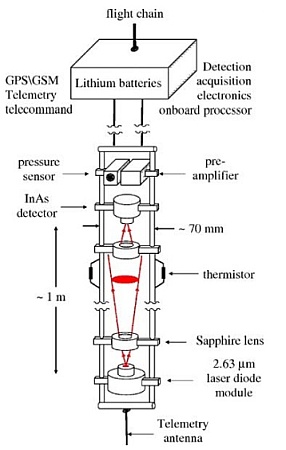Purpose of the flight and payload description
Pico-SDLA (Spectromètre à Diode Laser Accordable) is an hygrometer developed by the Division Technique of the Institut National des Sciences de l'Univers (DT-INSU) and the Groupe de Spectrométrie Moléculaire et Atmosphérique (GSMA) to measure in situ water vapour, CO2, and methane under small balloons in the upper troposphere (UT) and the lower stratosphere (LS). Is a smaller/lighter version of the former instruments SDLA and micro-SDLA. The main difference with its predecesors is that it uses a one-meter long path for the open cell instead of multi-pass cells. The H2O version uses two different spectral lines (the more intense line is chosen for the stratosphere) to perform measurement up to 25 km.
In the figure at left we can see a scheme of the mounting of the laser sensor. The principle of the sensor is simple: the laser beam is propagated in the open atmosphere where it is partially absorbed by ambient H2O molecule, then, the amount of absorbed energy is related to the molecular density using the Beer-Lambert law. The laser diode is mounted in a small mechanical module made of aluminum and Teflon. Great care was taken in the thermal design of this laser module because of the large variation of the ambient temperature encountered during a balloon flight. Two fiber carbon tubes are used to maintain the laser diode and the 1 mm diameter InAs detector at a one meter distance apart. Two Sapphire lenses with a focal length of 25 mm and anti-reflection coated are used to ensure the optical combination. Simultaneously to the in situ absorption spectra, the atmospheric pressure and temperature are recorded using a small pressure gauge and three meteorological thermistors. To prevent pollution by H2O outgassing from the balloon envelope, a long flight chain is used.
The PicoSDLA is capable of fully unattended operation; a Pentium type processor controls the data acquisition and storage, the interfacing with telemetry and GPS-GSM subsystems as well as the driving of the laser diode. A GPS device gives information on the position of the sensor. The GPS device is coupled to a GSM (global system for mobile communication) subsystem; once the sensor has landed, several SMS (short message service) messages detailing position information are sent regularly to permit the recovery of the gondola. The weight of the realized laser sensor and all sub-systems is of roughly 800 g which makes the instrument perfect to be used with small balloons.
There were developed also other variants with small changes of the original design of the instrument adapted to specific measurements. Pico-SDLA CO2 is a similar version of pico-SDLA H2O except that it uses a 0,5 m long path, and absorption at 2.68 µm. A third version of pico-SDLA is dedicated to the measurement of methane. In contrast to the H2O and the CO2 sondes, the Pico-SDLA-CH4 is based on the use of a Compact Difference Frequency Generation (CDFG) laser source which emits at 3.24 µm allowing measurements of CH4 in the middle atmosphere with a optical path length of 3.6 m.
Details of the balloon flight
Balloon launched on: 1/28/2013 at 11:50 utc
Launch site: Meteorological Research Institute, Baurú, Sao Paulo, Brazil
Balloon manufacturer/size/composition: Zero Pressure Balloon
End of flight (L for landing time, W for last contact, otherwise termination time): 1/26/2013
Campaign: TRO-PICO
This flight was part of the TRO-Pico campaign performed in Brazil between 2012 and 2013. It aims at studying deep convection in the tropics and more precisely, the impact of overshooting convection in the lower stratosphere on the stratospheric water budget, from the local to the continental scale.
External references
- Présentation de Pico-SDLA DT-INSU website
- TRO-pico campaign website University of Reims Champagne Ardenne
12604If you consider this website interesting or useful, you can help me to keep it up and running with a small donation to cover the operational costs. Just the equivalent of the price of a cup of coffee helps a lot.


